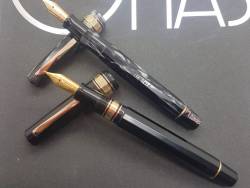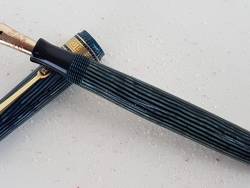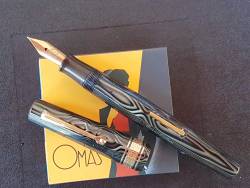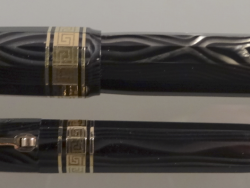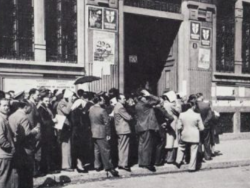FROM THE KING TO RADIUS
A fascinating chapter in the history of the Fountain Pen in Italy. 1926/1950s
History Pills - 1920/1935
The S.A.F.I.S. company, originally called “Pennini The King", was one of the major fountain pen manufacturers in Italy from the mid-1920s to the second half of the 1950s.
Founded by Enrico Lattes in 1926s, it changed its registered name into S.A.F.I.S. (Società Anonima Fabbrica Italiana Stilografiche) in the 1930’s.
S.A.F.I.S.’s production included models branded The King that were initially made in ebonite (mainly safeties) and later also in celluloid. These were very high quality pens with very refined and elegant aesthetic features. Early models followed the Duofold fashion of the time, evolving from simple flat tops with two thin cap rings to more refined streamlined models with greek key cap bands. The models of the 1930's will show instead a more modern design, reminiscent of the "Equipoised style", with rich pierced cap bands.
The King celluloid models (Superior, Diamond and Derby) are undoubtedly among the best Italian products of the past and represent an extremely important chapter in the production history of our country in the field of writing instruments. What characterizes The King pens is an original and refined aesthetic research, which is evident in all the company's lines: in the choice of overlay decorations, in the selection of celluloid colors and finally in the attention to finishing details and packaging.
The models produced from the 1920s to the second half of the 1930s are among the most beautiful of the entire Italian production panorama of the time.
https://www.tenpen.it/product/king-superior-black-and-bronze-celluloid
Like few important companies on the Italian scenario of the time, S.A.F.I.S. paid particular attention to the feminine market with the production of small-sized writing instruments in refined celluloid often associated with mechanical pencils, which were offered in exquisitely crafted, extremely elegant packages. The same care for the packaging was also applied to the standard-sized pens, which were offered in high-quality boxes, sometimes covered with unusual decorative motifs.
From a technical point of view, S.A.F.I.S. has never used the side lever for its celluloid models. For the models of the 30s, the button filling mechanism and a typical twist filling mechanism (The King patent) were used, traces and references of which can also be found in the Omas archives (see following Notes).
Autarchic policy and its effects on production - 1934/1946
The term “autarchy” refers to an economic policy based on self-sufficiency aimed at the absolute independence of a nation from economic and commercial exchanges with other countries.
The first reference to autarchy in Italy can be traced back historically to Mussolini’s speech in August 1935, when for the first time it was announced that Italy “would manage on its own” in response to the threat of sanctions by the League of Nations.
Actually the autarchy regime only began in 1937; the new economic policy of self-sufficiency envisaged not only a drastic reduction in imports and the organization of a regime of autonomy and economic self-sufficiency, but also a radical revision of commercial language and communications.
In the world of pens, which until then had exploited the Anglophone etymology to promote its products (terms such as fountain pen, made in USA, safety pen etc. were very common), autarchy determined a drastic change of direction. All the wordings and names of foreign origin were abandoned to become absolutely Italian.
New brands began to proliferate that referred to Imperial Rome (Augusta, Aurea, Ausonia, Imperiale, Caesar etc.), to fascist propaganda (Littoria, Balilla, Dux, Italianissima, Audax, Vittoria etc.) and to the classical world.
It was in fact as a consequence of the autarchic legislation that many companies also had to change their company name, eliminating the Anglophone terminology in favour of Italian terms.
The company S.A.F.I.S. therefore had to abandon the prestigious brand The King and adopt a new name for its products. The choice fell on the name Radius, which means “ray”, easy to remember, simple, short and of Latin origin, therefore perfectly in line with the new autarchic dictates.
The brand was actually registered in 1934, probably with the intention of placing it alongside the prestigious line of The King and. We cannot rule out that the first Radius pens were actually produced at the same time as the last The King between 1934 and 1937, as demonstrated by many Radius models of these years with aesthetic and technical characteristics identical to The King models.
https://www.tenpen.it/product/radius-superior-burgundy-and-black-celluloid
The two ranges of pens, The King and Radius, have in common the use of the name “Superior” to indicate their top lines. The Diamond denomination that was instead used for the The King line parallel to the Superior, was later abandoned and replaced with the simpler definition “Extra”.
Starting from the second half of the 30s, with the definitive disappearance of the The King brand, Radius fountain pens became S.A.F.I.S. ’s flagships, preserving intact the principles of construction quality and refined aesthetic research typical of the company.
Radius fountain pens were produced both as button and lever fillers, with a cylindrical and faceted design in four sizes. These are sturdy and reliable pens where the oversize size exceeds 14 cm. They are characterized by a typical shaped clip and a pierced cap band with diamond designs that fits perfectly into the Art Deco style of the time.
Radius models were produced in a wide range of marbled and veined celluloids with initially rolled gold metalware and gold nibs and later with chrome finishes and steel nibs in compliance with the dictates of autarchy that prohibited the use of gold in any product.
With a view to commercial diversification, in the early 1940s, the flagship Superior and Extra lines were joined by a new line intended for the mid-range market, which was called Astura. These are less elaborate pens, intended for the student market and for large-scale distribution, which were produced with both steel nibs and gold nibs. The finishes varied from a single ring with inlays to small waves, three rings on the cap and other types of finishes of economic appearance..
Finally, among the Radius models of the early 1940s, it is worth mentioning the Trasparente model, produced in a particular celluloid with a geometric effect that clearly recalls the famous Waterman Ink View models. The peculiarity of the Transparent Radius model is the transparency of the barrel that allows you to check the ink level without adopting a piston filling mechanism. The Transparent Radius is a button filler structured in such a way as to house the ink sac in the rear part of the barrel and leave the lower part free to accommodate the ink.
In the post-war years, the lines of Radius fountain pens were renewed to take on a tapered ogival design, in tune with the new taste of the time. The cap finishes became linear and essential, with a high band on the edge of the cap and an extremely simple clip. The piston filling system was adopted on these models.
https://www.tenpen.it/product/radius-extra-facetted-tortoise-marbled-celluloid
In the 1950s, the The King brand was finally recovered, now finally freed from the censorship of the Fascist era, with the introduction of a model with a tapered and modern design with Vacumatic type filling mechanism called “Dreampen”, flanked by a very similar model called “Superior”, which was a button filler.
The relevant feature of this model was the large, lanceolate and in many cases flexible The King nib, which substantially contrasted with the trend of the time towards small, hooded nibs. A version with semi-hooded nib was introduced, too, in order to keep up with the mainstream fashion of the time.
In line with S.A.F.I.S. tradition, the The King Dreampen and Superior of the 1950s were also models of excellent quality, characterized by an attention to aesthetics and care for details, such as the small shield with the initials "TK" positioned on the back of the cap and the choice of ringed and arch-style lined celluloids.
https://www.tenpen.it/product/king-dream-pen-vacuum-filler-laminated-celluloid
Unfortunately, despite the adoption of quality celluloids, the new Radius and The King models failed to establish themselves on the market successfully. The late Radius productions, with the Comet model, produced mainly in black and dark colors, failed to change the fate of the company, crushed by competition from German and American giants.
Production stopped in the mid-1950s.
Connections between The King and Omas
The relationship between Omas and The King represents a part of the history of the Italian fountain pen that is still shrouded in mystery. Links and connections between the two companies certainly existed, as demonstrated by the existence of Doctor's pens marked The King with an Omas patent and the fact that the patent for the twist filling mechanism, typical of the top of the line The King models of the 1930s, was registered by Armando Simoni.
In the booklet "Stilografiche Omas dal 1925 ai Giorni Nostri" published in the early 1990s by the Club Internazionale della Stilografica (an Association born within the Omas company itself), it is specified that a The King catalogue (the only one known to exist) was found in the Omas archives. In this case, the catalogue would have been proof that The King pens were produced by the Omas company.
This interpretation, typical of the 90s, is part of an effort by the Omas company at the time to attribute the production of many prestigious brands in the Italian panorama to Armando Simoni.
A more objective approach to the relationship between the two companies could instead open up different scenarios, including the hypothesis of a commissioned production by the Turin company of some Omas models (in particular Duofold style models from the late 20s). The similarity of some celluloids suggests the possibility of a common origin, which however becomes less and less plausible starting from the early 30s onwards with the development of completely different production lines, such as the Omas Extra line with side lever.
Indications of a very close relationship between Omas and The King also come from observing the nibs. The very first Omas nibs and the very first The King nibs suggest a common origin, both for the geometry and for the drop-shaped aeration hole, which was then replaced by the heart-shaped hole in the early 1930s.
Given the production variety and the aesthetic characteristics of many The King lines, it is extremely risky to suppose that they could have been produced by Omas. S.A.F.I.S. was a structured company well-established in the Turin production area, one of the most active and prolific in the Italian panorama of fountain pen and writing instrument production.
We have therefore to wait till documentary evidence or unmistakable proofs will be found to establish if it was Omas which manufactured The King celluloid models of the 1930's or vice-versa.





















